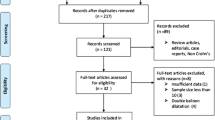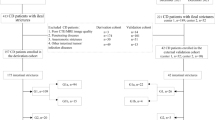Abstract
Background
Crohn’s disease (CD) is frequently complicated by intestinal strictures, which are commonly treated by endoscopic balloon dilation (EBD). However, available data on this area of treatment is limited. The aim of this study was to depict the heterogeneity of endoscopic management of CD-associated strictures among international CD specialists to identify common treatment standards.
Methods
IBD experts of the International Organization for the Study of Inflammatory Bowel Disease (IOIBD), the European Crohn’s and Colitis Organization (ECCO), and from the Prospective Value In IBD trials (PROVIT) completed a web-based questionnaire to evaluate their endoscopic experience, practice setting, and number of EBDs performed annually. Additionally, two case scenarios and technical practice parameters were investigated.
Results
A total of 126 subjects from 15 countries completed the survey. The maximal length of dilated stricture was 4.5 ± 1.7 cm. The most commonly used maximal balloon size was graded as 15–18 mm. While 87.2 % of the participants favored EBD for anastomotic strictures, only 58.6 % did so in the case of naïve strictures. Only 35.7 % of physicians dilated actively inflamed strictures. Interventional endoscopists were more likely to dilate only clinically symptomatic strictures (p = 0.046). Surgeons favored surgical treatment of de novo ileocecal strictures compared to gastroenterologists (p = 0.026), reported a shorter stricture length being amendable by EBD (p = 0.045), and more frequently used concomitant therapies (p = 0.001). Operator experience increased the likelihood of EBD use in actively inflamed strictures (p = 0.002), maximum length of stricture, and maximum balloon size (p = 0.001).
Conclusions
EBD is a widely used treatment approach for stricturing CD. Individual approaches differ significantly based on background of the operator, experience level, and practice setting.


Similar content being viewed by others
Abbreviations
- EBD:
-
Endoscopic balloon dilatation
- SP:
-
Strictureplasty
- TNF-α:
-
Tumor necrosis factor-alpha
- CD:
-
Crohn’s disease
- TTS:
-
Through-the-scope
- psi:
-
Pounds per square inch
References
Baumgart DC, Sandborn WJ. Crohn’s disease. Lancet. 2012;380(9853):1590–605.
Solberg IC, Vatn MH, Hoie O, et al. Clinical course in Crohn’s disease: Results of a Norwegian population-based ten-year follow-up study. Clin Gastroenterol Hepatol. 2007;5(12):1430–8.
Peyrin-Biroulet L, Harmsen WS, Tremaine WJ, et al. Surgery in a population-based cohort of Crohn’s disease from Olmsted County, Minnesota (1970–2004). Am J Gastroenterol. 2012;107(11):1693–701.
Cosnes J, Nion-Larmurier I, Beaugerie L, et al. Impact of the increasing use of immunosuppressants in Crohn’s disease on the need for intestinal surgery. Gut. 2005;54(2):237–41.
Bettenworth D, Rieder F. Medical therapy of stricturing Crohn’s disease: What the gut can learn from other organs—a systematic review. Fibrogenesis Tissue Repair. 2014;7(1):5.
Yamamoto T, Fazio VW, Tekkis PP. Safety and efficacy of strictureplasty for Crohn’s disease: A systematic review and meta-analysis. Dis Colon Rectum. 2007;50(11):1968–86.
Rutgeerts P, Geboes K, Vantrappen G, et al. Natural history of recurrent Crohn’s disease at the ileocolonic anastomosis after curative surgery. Gut. 1984;25(6):665–72.
Shivananda S, Hordijk ML, Pena AS, et al. Crohn’s disease: Risk of recurrence and reoperation in a defined population. Gut. 1989;30(7):990–5.
Rieder F, Zimmermann EM, Remzi FH, et al. Crohn’s disease complicated by strictures: A systematic review. Gut. 2013;62(7):1072–84.
Blomberg B, Rolny P, Jarnerot G. Endoscopic treatment of anastomotic strictures in Crohn’s disease. Endoscopy. 1991;23(4):195–8.
Williams AJ, Palmer KR. Endoscopic balloon dilatation as a therapeutic option in the management of intestinal strictures resulting from Crohn’s disease. Br J Surg. 1991;78(4):453–4.
Holtmann M, Wanitschke R, Helisch A, et al. Anti-TNF antibodies in the treatment of inflammatory intestinal stenoses in Crohn’s disease. Z Gastroenterol. 2003;41(1):11–7. (Anti-TNF-Antikorper zur Therapie von entzundlichen Darmstenosen bei Morbus Crohn).
Hassan C, Zullo A, De Francesco V, et al. Systematic review: Endoscopic dilatation in Crohn’s disease. Aliment Pharmacol Ther. 2007;26(11–12):1457–64.
Saunders BP, Brown GJ, Lemann M, et al. Balloon dilation of ileocolonic strictures in Crohn’s disease. Endoscopy. 2004;36(11):1001–7.
Felley C, Vader JP, Juillerat P, et al. Appropriate therapy for fistulizing and fibrostenotic Crohn’s disease: Results of a multidisciplinary expert panel—EPACT II. J Crohns Colitis. 2009;3(4):250–6.
Annese V, Daperno M, Rutter MD, et al. European evidence based consensus for endoscopy in inflammatory bowel disease. J Crohns Colitis. 2013;7(12):982–1018.
East JE, Brooker JC, Rutter MD, et al. A pilot study of intrastricture steroid versus placebo injection after balloon dilatation of Crohn’s strictures. Clin Gastroenterol Hepatol. 2007;5(9):1065–9.
Thomas-Gibson S, Brooker JC, Hayward CM, et al. Colonoscopic balloon dilation of Crohn’s strictures: A review of long-term outcomes. Eur J Gastroenterol Hepatol. 2003;15(5):485–8.
Chen M, Shen B. Endoscopic therapy in Crohn’s disease: Principle, preparation, and technique. Inflamm Bowel Dis. 2015;21(9):2222–40.
Bettenworth D, Lopez R, Gustavsson A, et al. Efficacy, safety and long term outcome of endoscopic dilation therapy for stricturing Crohn’s disease—a combined analysis of 3252 endoscopic balloon dilations procedures. Gastroenterology. 2015;147(5):S239–S240. DDW abstract #2152144.
Atreja A, Aggarwal A, Dwivedi S, et al. Safety and efficacy of endoscopic dilation for primary and anastomotic Crohn’s disease strictures. J Crohns Colitis. 2014;8(5):392–400.
Thienpont C, D’Hoore A, Vermeire S, et al. Long-term outcome of endoscopic dilatation in patients with Crohn’s disease is not affected by disease activity or medical therapy. Gut. 2010;59(3):320–4.
Paine E, Shen B. Endoscopic therapy in inflammatory bowel diseases (with videos). Gastrointest Endosc. 2013;78(6):819–35.
Thienpont C, Van Assche G. Endoscopic and medical management of fibrostenotic Crohn’s disease. Dig Dis. 2014;32(Suppl 1):35–8.
Krauss E, Agaimy A, Gottfried A, et al. Long term follow up of through-the-scope balloon dilation as compared to strictureplasty and bowel resection of intestinal strictures in crohn’s disease. Int J Clin Exp Pathol. 2014;7(11):7419–31.
Bharadwaj S, Fleshner P, Shen B. Therapeutic armamentarium for stricturing Crohn’s disease: Medical versus endoscopic versus surgical approaches. Inflamm Bowel Dis. 2015;21(9):2194–213.
Wibmer AG, Kroesen AJ, Grone J, et al. Comparison of strictureplasty and endoscopic balloon dilatation for stricturing Crohn’s disease–review of the literature. Int J Colorectal Dis. 2010;25(10):1149–57.
de’Angelis N, Carra MC, Borrelli O, et al. Short- and long-term efficacy of endoscopic balloon dilation in Crohn’s disease strictures. World J Gastroenterol. 2013;19(17):2660–7.
Gustavsson A, Magnuson A, Blomberg B, et al. Endoscopic dilation is an efficacious and safe treatment of intestinal strictures in Crohn’s disease. Aliment Pharmacol Ther. 2012;36(2):151–8.
Endo K, Takahashi S, Shiga H, et al. Short and long-term outcomes of endoscopic balloon dilatation for Crohn’s disease strictures. World J Gastroenterol. 2013;19(1):86–91.
Couckuyt H, Gevers AM, Coremans G, et al. Efficacy and safety of hydrostatic balloon dilatation of ileocolonic Crohn’s strictures: A prospective long-term analysis. Gut. 1995;36(4):577–80.
Nomura E, Takagi S, Kikuchi T, et al. Efficacy and safety of endoscopic balloon dilation for Crohn’s strictures. Dis Colon Rectum. 2006;49(10 Suppl):S59–67.
Chatu S, Subramanian V, Saxena S, et al. The role of thiopurines in reducing the need for surgical resection in Crohn’s disease: A systematic review and meta-analysis. Am J Gastroenterol. 2014;109(1):23–34 quiz 5.
Loras C, Perez-Roldan F, Gornals JB, et al. Endoscopic treatment with self-expanding metal stents for Crohn’s disease strictures. Aliment Pharmacol Ther. 2012;36(9):833–9.
Acknowledgments
This work was supported by a research fellowship from the Faculty of Medicine, Westfälische Wilhelms-Universität Münster, awarded to D.B. This work was supported by grants from the National Institutes of Health (1T32DK083251) and the European Crohn’s and Colitis Foundation, awarded to F.R.
Author information
Authors and Affiliations
Corresponding author
Ethics declarations
Conflict of interest
The authors declare that they have no conflict of interest.
Additional information
D. Bettenworth and F. Rieder both contributed equally to this manuscript.
Electronic supplementary material
Below are the links to the electronic supplementary material.
Rights and permissions
About this article
Cite this article
Bettenworth, D., Lopez, R., Hindryckx, P. et al. Heterogeneity in endoscopic treatment of Crohn’s disease-associated strictures: An international inflammatory bowel disease specialist survey. J Gastroenterol 51, 939–948 (2016). https://doi.org/10.1007/s00535-016-1172-6
Received:
Accepted:
Published:
Issue Date:
DOI: https://doi.org/10.1007/s00535-016-1172-6




